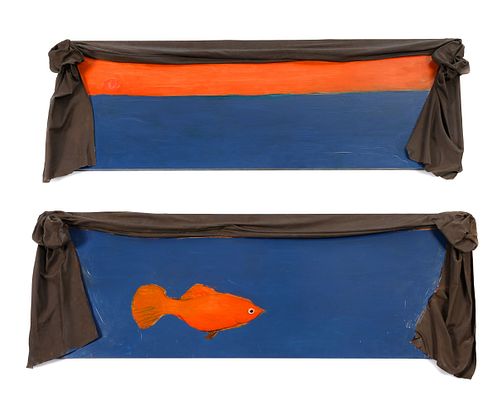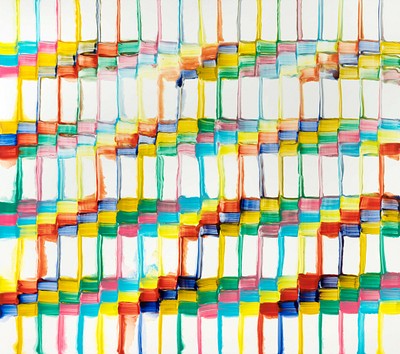Ree Morton (American, 1936-1977) Regional Piece, 1976 (diptych)
Lot 78
About Seller
Hindman
1338 West Lake Street
Chicago, IL 60607
United States
Recognized as the Midwest's leading fine art auctioneers, Hindman Auctioneers has built a worldwide reputation based on a full service approach to the auction business tailored to meet the individual needs of our clients. Coming from a variety of educational backgrounds, specialists bring years of e...Read more
Estimate:
$15,000 - $25,000
Absentee vs Live bid
Two ways to bid:
- Leave a max absentee bid and the platform will bid on your behalf up to your maximum bid during the live auction.
- Bid live during the auction and your bids will be submitted real-time to the auctioneer.
Bid Increments
| Price | Bid Increment |
|---|---|
| $0 | $25 |
| $500 | $50 |
| $1,000 | $100 |
| $2,000 | $250 |
| $5,000 | $500 |
| $10,000 | $1,000 |
| $20,000 | $2,500 |
| $50,000 | $5,000 |
| $100,000 | $10,000 |
About Auction
By Hindman
May 4, 2021
Set Reminder
2021-05-04 11:00:00
2021-05-04 11:00:00
America/New_York
Bidsquare
Bidsquare : Post War & Contemporary Art
https://www.bidsquare.com/auctions/hindman-auctions/post-war-contemporary-art-6796
Hindman Bidsquare@hindmanauctions.com
Hindman Bidsquare@hindmanauctions.com
- Lot Description
Ree Morton
(American, 1936-1977)
Regional Piece, 1976 (diptych)
oil on wood with celastic
Each: 20 x 40 inches.
Provenance:
Droll/Kolbert Gallery, New York
Obelisk Gallery, Boston. Massachusetts
Acquired from the above by the present owner in 1989
Exhibited:
New York, New York, New Museum, Ree Morton: A Retrospective 1971 - 1977, February 16 - April 17, 1980; Houston, Texas, Contemporary Arts Museum, Houston, May 20 - June 29, 1980; Boulder, Colorado, University of Colorado Museum, Boulder; Buffalo, January 17 -March 1, 1981; New York, Albright-Knox Art Gallery; Chicago, Illinois, Renaissance Society at the University of Chicago, March 15-April 19, 1981
Lot Note:
The elusive and enigmatic Ree Morton made an impactful and influential contribution to the art world, making more than the most of her woefully brief, less than a decade span of creation. Morton, rarely one for the more ordinary path, came to formal artmaking later than usual after starting a family and only drawing as ideal pursuit. An artist's artist, her unique and visionary practice layered conceptual aspects of feminism, minimalism, semiotics and regionalism, realized most recognizably as ambiguous narrative objects that straddle painting, sculpture and craft. Often cloaked in veils of sly innocence and ironic humor to disguise the sharp teeth of biting social commentary and a subversive nature at the core of the work. Morton pioneered the use of Celastic, an industrial plastic impregnated fabric originally used for theatrical prop making that can shaped when saturated and dries hard, holding form, as fine art media creating low relief curtains, flowers, ribbons and bows employed as perplexing and alluring accents and framing devices. Regional Piece, 1976 is part of a series of 12 vertical stacked horizontal seascape diptychs, many of which are held in museum collections, that comprised one of the last bodies of work she produced before her tragic death in a 1977 car accident. All painted in San Diego the Regional Piece works pair upper paintings of austere ocean sunsets above a lower paintings of a lone fish swimming at unknown depths, a speck in the vastness. Both picture planes bordered by open sculptural curtains, implying stages or windows, portals to displays, inviting the attention of an audience. Purposefully sentimental, but with a subtle edginess that avoids drifting to saccharine, thematically these works explore the existential reality of individual insignificance in the immeasurable expanse of the university or more literally as the title of the series might suggest being regionalized to a small fish in a big ocean. Regional Piece, 1976 is more overtly minimal than other examples in the series and arrestingly so, a limited palette of unmodulated complementary orange and blue applied in large passages devoid of texture express the sky water and fish, formally reading at once as a crisper version of Mark Rothko color field and more directly sideways Barnett Newman stripes, bolstering the narrative component with purely abstract aesthetics. Black and white are sparingly used as detail on the fish and dark gray flowing drapery surround both panels, a supporting grayscale elevating and clarifying the more eyecatching color focal points. Additionally, the seemingly decorative for decorations sake curtains function as a disarming dose of cheeky camp offsetting the stark seriousness of the symbolism and making a heavy topic more accessible and comprehensible. This wonderfully beguiling and encapsulating example of both the Regional Piece series and Morton's entire oeuvre was importantly included in her posthumous 1980 retrospective Ree Morton: Retrospective 1971-1977, that curated by Alan Schwartzman and Kathleen Thomas for the New Museum in New York City and traveled to institutions in Houston, Boulder, Buffalo and Chicago.
Property from a Private CollectionCondition
For condition inquiries please contact nathanbrady@hindmanauctions.com. - Shipping Info
-
Please refer to https://hindmanauctions.com/shipping-packing
-
- Buyer's Premium



 EUR
EUR CAD
CAD AUD
AUD GBP
GBP MXN
MXN HKD
HKD CNY
CNY MYR
MYR SEK
SEK SGD
SGD CHF
CHF THB
THB













